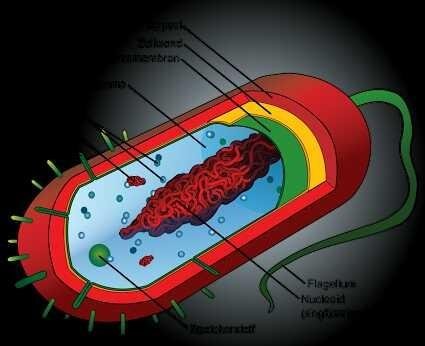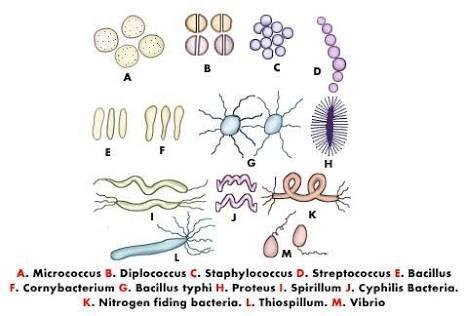Bacteria are the most numerous organisms and are more widespread than other living things.
Bacteria have hundreds of thousands of species that live on land to sea and in extreme places.
Bacteria are beneficial but others are harmful. Bacteria have characteristics that distinguish it from other living things. Bacteria are unicellular and prokaryotic organisms and generally have no chlorophyll and are microscopic.
Bacterial Characteristic

Bacteria are the most successful organisms on the planet. They lived on this planet for two billion years before the first eukaryotes and, during that time, evolved into millions of different species.
Bacteria have characteristics that distinguish it from other living things, namely:
- Multicellular organisms
- Prokaryotes (do not have cell nuclear membranes)
- Generally do not have chlorophyll
- Having a body size that varies between 0.12 s / d hundreds of microns generally have an average size of 1 s / d 5 microns.
- Has a diverse body shape
- Free living or parasites
- Living in extreme environments such as in hot springs, craters or peat wall cells do not contain peptidoglycan
- Cosmopolitan living in various environments cell walls contain peptidoglycan
Bacterial Structure
The structure of bacteria is divided into two namely:
- The basic structure (owned by almost all types of bacteria) Includes: cell wall, plasma membrane, cytoplasm, ribosome, DNA, and storage granules
- Additional structures (owned by certain types of bacteria) Includes capsules, flags, pilus, fimbria, klorosom, gas vacuoles and endospores.
The basic structure of bacterial cells
- The cell wall is composed of peptidoglycan, combining proteins and polysaccharides (peptidoglycan thickness divides bacteria into gram-positive bacteria when the peptidoglycan is thick and gram-negative bacteria when the peptidoglycan is thin).
- The plasma membrane is the membrane covering the cytoplasm composed of layers of phospholipids and proteins.
- Cytoplasm is cell fluid.
- Ribosomes are organelles that are dispersed in the cytoplasm, composed of proteins and RNA.
- Storage granules, because bacteria store food reserves needed.
Additional structure of bacteria:
- Capsule or layer of mucus is a layer outside the cell wall in certain bacteria, when Its thick layer is called a capsule and when a thin layer is called a layer of mucus. Capsules and lining of mucus are composed of polysaccharides and water.
- Flagus or whip hair is a rod or spiral structure that protrudes from the cell wall.
- Pilus and fimbria are fine hair-shaped structures protruding from the cell wall, the pilus is similar to the shorter but shorter, stiffer and smaller diameter and is composed of proteins and is present only in gram-negative bacteria. Fimbria are structures of a type of pilus but shorter than the pilus.
- Chlorosomes are structures just below the plasma membrane and contain chlorophyll pigments and other pigments for photosynthesis. Klorosom is found only in bacteria that perform photosynthesis.
- Vakuola gas is present in bacteria that live in water and photosynthesize.
- Endospores are a form of rest (latent) of some types of gram-positive bacteria and are formed in bacterial cells if conditions are unfavorable for bacterial life. Endospores contain little cytoplasm, genetic material, and ribosomes. Thick endospora walls are composed of proteins and cause endospores to withstand drought, light radiation, high temperatures and chemicals. If environmental conditions benefit the endospores will grow into new bacterial cells.
Form Bacteria

The basic forms of bacteria consist of round shape (coccus), stem (bacillus), and spiral (spirilia) and there is a form between coccus and bacillus called cocobacil.
Various forms of bacteria:
1. Cocci bacteria
a. Monococcus
b. Diplococcus
c. Tetracoccus
d. Sarcina
e. Streptococcus
f. Stapilococcus
2. Bacilli Bacteria:
a. Monobacilli
b. Diplobacilli
c. Streptobacilli
3. Spirilli bacteria:
a. Spiral is a wavy cell shape
b. Spiroseta is a cell shape like a screw
c. Vibrio is a cell shape like a comma punctuation
Bacteria Motion Tools
The movement of bacteria in the form of flagellum or whip hair is a rod-shaped or spiral structure protruding from the cell wall. Flagellum allows bacteria to move toward favorable environmental conditions and avoid harmful environments for their lives.
Factors Affecting Bacterial Growth
Growth in bacteria means cell multiplication and an increase in population size.
Factors affecting bacterial growth or conditions for optimum growth are:
- Temperature
- Degree of acidity or pH
- Salt concentration
- Sources of nutrition
- Substances of waste metabolism
- Chemicals
Bacterial growth
Bacterial growth is the asexual reproduction, or cell division, of a bacterium into two daughter cells, in a process called binary fission. Providing no mutational event occurs, the resulting daughter cells are genetically identical to the original cell. Hence, "local doubling" of the bacterial population occurs. Both daughter cells from the division do not necessarily survive.
However, if the number surviving exceeds unity on average, the bacterial population undergoes exponential growth. The measurement of an exponential bacterial growth curve in batch culture was traditionally a part of the training of all microbiologists; the basic means requires bacterial enumeration (cell counting) by direct and individual (microscopic, flow cytometry), direct and bulk (biomass), indirect and individual (colony counting), or indirect and bulk (most probable number, turbidity, nutrient uptake) methods. Models reconcile theory with the measurements.
The Role of Bacteria
In human life bacteria have a beneficial or adverse role.
The beneficial bacteria are as follows:
- Decay (decomposition of the remains of living things such as Escherichia coli).
- Making fermented foods and beverages such as Acetobacter in the manufacture of vinegar, Lactobacillus bulgaricus in the manufacture of yoghurt, Acetobacter xylinum on the manufacture of nata de coco and Lactobacillus casei on the manufacture of yoghurt cheese.
- Role in the nitrogen cycle as a nitrogen-fixing bacteria Rhizobium leguminosarum that lives symbiotically with the roots of plant nuts and Azotobacter chlorococcum.
- Soil fertilizer for example Nitrosococcus and Nitrosomonas that play a role in the process of nitrification produce nitrate ions that plants need.
- An antibiotic producer for example is Bacillus polymyxa (polymyxin antibiotic producer B for the treatment of gram negative bacterial infection
- Bacillus subtilis antibiotics producer for the treatment of gram positive bacterial infection Streptomyces griseus produces streptomycin antibiotics for the treatment of gram-negative bacteria including tuberculosis-causing bacteria and Streptomyces rimosus producer antibiotic terikiklin various bacteria.
- Preparation of chemicals such as acetone and butanol by Clostridium acetobutylicum
Plays a role in the process of decomposing waste and animal waste so as to produce alternative energy of methane in the form of biogas. For example methanobacterium. - Genetic engineering research in various fields. For example in the field of medicine are produced drugs and useful chemical products synthesized by bacteria, such as enzymes, vitamins and hormones.
The harmful bacteria are as follows:
- Decomposition of food for example Clostridium botulinum
- Causes of human illness are Mycobacterium tuberculosis, Vibrio cholerae, Clostridium tetani (the cause of tetanus disease) and Mycobacterium leprae (the cause of leprosy)
- The causes of disease in animals such as Bacilluc antrachis (the cause of anthrax disease in cattle)
- The causes of disease in cultivated plants for example Pseudomonas solanacearum (the cause of diseases in tomato plants, lombok, eggplant and tobacco) and Agrobacterium tumafaciens (the cause of tumors in plants).
Source :
Copying/Pasting full texts without adding anything original is frowned upon by the community.
Some tips to share content and add value:
Repeated copy/paste posts could be considered spam. Spam is discouraged by the community, and may result in action from the cheetah bot.
If you are actually the original author, please do reply to let us know!
Thank You!